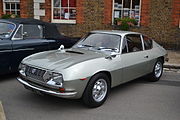
Giovanni Michelotti was one of the most prolific designers of sports cars in the 20th century. His notable contributions were for Ferrari, Lancia, Maserati and Triumph marques. He was also associated with truck designs for Leyland Motors, and with designs for British Leyland after the merger of Leyland and BMC.

Giorgetto Giugiaro is an Italian automotive designer. He has worked on supercars and popular everyday vehicles. He was named Car Designer of the Century in 1999 and inducted into the Automotive Hall of Fame in 2002. He was awarded the Compasso d'Oro industrial design award six times.
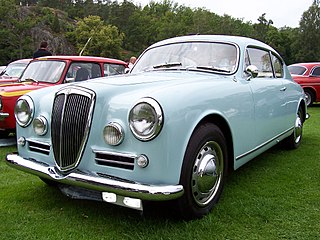
A grand tourer (GT) is a type of car that is designed for high speed and long-distance driving with performance and luxury. The most common format is a front-engine, rear-wheel-drive two-door coupé with either a two-seat or a 2+2 arrangement. Grand tourers are often the coupé derivative of luxury saloons or sedans. Some models, such as the Ferrari 250 GT, Jaguar E-Type, and Aston Martin DB5, are considered classic examples of gran turismo cars.

Zagato is a coachbuilding company founded by Ugo Zagato in 1919. The design center of the company is located in Terrazzano, a village near Rho, Lombardy, Italy.
Vignale is the luxury car sub-brand of Ford Motor Company used in automobiles sold in Europe. The former company Carrozzeria Alfredo Vignale was an Italian automobile coachbuilder established in 1948 at Via Cigliano, Turin, by Alfredo Vignale (1913–69). After its founder's death in 1969, Carrozzeria Vignale was acquired by De Tomaso. The studio ceased operation in 1973, but ownership of the name was taken over by Ford Motor Company.

The Aston Martin DB4 GT Zagato is a grand tourer sports car designed by Zagato and produced between 1960 and 1963. Introduced in October 1960 at the London Motor Show, it was effectively a DB4 GT, lightened and improved by the Zagato factory in Italy, by Ercole Spada. Initially, the factory planned to produce 25 cars, but demand was not as strong as expected and production was reduced to 19.

Carrozzeria Touring Superleggera is an Italian automobile coachbuilder. Originally established in Milan in 1925, Carrozzeria Touring became well known for both the beauty of its designs and patented superleggera construction methods. The business folded in 1966. In 2006 its brands and trademarks were purchased and a new firm was established nearby to provide automotive design, engineering, coachbuilding, homologation services, non-automotive industrial design, and restoration of historic vehicles.

The Lancia Fulvia is a car produced by Lancia between 1963 and 1976. Named after Via Fulvia, the Roman road leading from Tortona to Turin, it was introduced at the Geneva Motor Show in 1963 and manufactured in three variants: Berlina 4-door saloon, 2-door Coupé, and Sport, an alternative fastback coupé designed and built by Zagato on the Coupé floorpan.

The Geneva International Motor Show was an annual auto show held in March in the Swiss city of Geneva.

The Lancia Flavia is an executive car produced by Italian automaker Lancia from 1961 to 1971.
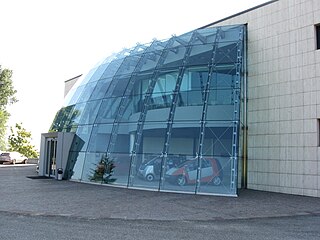
Pininfarina S.p.A. is an Italian car design firm and coachbuilder, with headquarters in Cambiano, Turin, Italy. The company was founded by Battista "Pinin" Farina in 1930. On 14 December 2015, the Indian multinational Mahindra Group acquired 76.06% of Pininfarina S.p.A. for about €168 million.

The Lancia Dedra is a compact executive car produced by the Italian automaker Lancia from 1989 to 1999. It was initially designed to support, and went on to replace, the Prisma which, six years after its launch, was having difficulty remaining competitive in the market. It was based on a stretched version of the platform underpinning the second generation of the Delta and is often considered a saloon variant of the Delta.
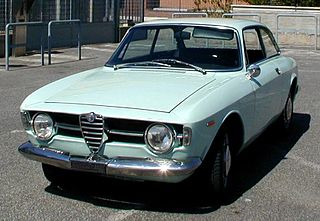
The Alfa Romeo 105 and 115 series coupés are a range of cars made by the Italian manufacturer Alfa Romeo from 1963 until 1977, based on a shortened floorpan from the Giulia saloon. They were the successors to the Giulietta Sprint coupé.

The Alfa Romeo Giulietta is a family of automobiles made by Italian car manufacturer Alfa Romeo from 1954 until 1965 which included a 2+2 coupé, four-door saloon, estate, spider, Sprint, and Sprint Speciale. The 2+2 was Alfa Romeo's first successful foray into the 1.3-litre class. From 1954 to 1965 a total of 177,690 Giuliettas were made, the great majority in saloon (Berlina), Sprint coupé, or Spider body styles, but also as Sprint Speciale and Sprint Zagato coupés, and the rare Promiscua estate.

I.DE.A Institute was an automobile design and engineering company in Turin, Italy, founded in 1978 by Franco Mantegazza and architect Renzo Piano, with engineer Peter Rice as Vice President.
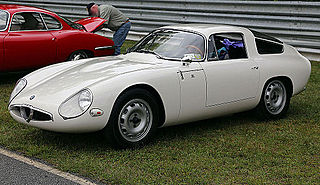
The Alfa Romeo Giulia TZ was a sports car and racing car manufactured by Alfa Romeo from 1963 to 1967. It replaced the Giulietta SZ. In 2011, the name was reduced from Giulia TZ to TZ in the new TZ3 model.

Meccanica Bessana Toys, was an Italian toy manufacturer that produced die-cast scale model cars during the 1960s and 1970s.
The Turin Motor Show is an auto show held annually in Turin, Italy. The first official show took place between 21 and 24 April 1900, at the Castle of Valentino, becoming a permanent fixture in Turin from 1938 having shared it with Milan and Rome until that time. From 1972, the show was held biannually and in 1984, it moved into Fiat's shuttered Lingotto factory.

Polistil S.p.A. is an Italian toy brand and former manufacturing company headquartered in Milan, with production center in Chiari, near Brescia. Polistil specialized in die-cast and plastic scale model vehicles of all sizes.
The Milano Monza Open-Air Motor Show (MIMO) is an annual auto show first held in June 2021 in Milan and Monza, Italy.




